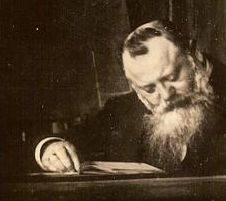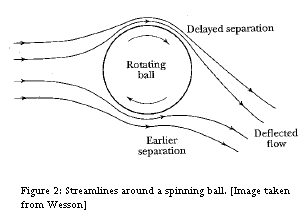The Spinning Golf Ball

When a golf ball
is hit, a spin is produced. It is
virtually impossible to hit a golf ball without having it spin.
The way the golf ball spins depend on how it is hit. A golf
ball that is hit by a
pro golfer spin in a horizontal axis and spin in such a way that the top of the ball is moving towards the golfer and the bottom is moving away. The thin region of the boundary layer
moves with the surface of the ball as it spins. The speed of the air on top of the ball is faster than that of the bottom in relative to the ball. We have learned the Bernoulli effect and
therefore know that the pressure on top of the ball would be less than that of the bottom of the ball. Which gives rise to an upward lift in the golf ball. (As some of you may know, if the
golf ball were to spin in the other direction, it would cause the ball to have a downward lift. This happens when you "top" the ball or when you hit the ball above its center. Likewise, a
spin that spins parallel in relation to the ground would have a sideways lift which gives a draw shot or a slice shot.)
pro golfer spin in a horizontal axis and spin in such a way that the top of the ball is moving towards the golfer and the bottom is moving away. The thin region of the boundary layer
moves with the surface of the ball as it spins. The speed of the air on top of the ball is faster than that of the bottom in relative to the ball. We have learned the Bernoulli effect and
therefore know that the pressure on top of the ball would be less than that of the bottom of the ball. Which gives rise to an upward lift in the golf ball. (As some of you may know, if the
golf ball were to spin in the other direction, it would cause the ball to have a downward lift. This happens when you "top" the ball or when you hit the ball above its center. Likewise, a
spin that spins parallel in relation to the ground would have a sideways lift which gives a draw shot or a slice shot.)

[Figure 1: Heinrich Magnus - (1802-1870) {Image taken from http://2008.wunstorf.nolis14.nol-is.de/archiv/main/geschichte12.htm}]
The path of the
ball
would then be of a curve path. This effect
is called the Magnus effect after Heinrich Magnus who did some
experiments on rotating cylinders. The viscous force in
the boundary layer of a spinning ball squeezes the air more strongly in the area where the spin of the ball is in the same direction than that of the airflow. (See figure 2.) The result is that
the separation doesn't happen until at a later time which causes the air flow to continue on round the surface of the ball. On the opposite side, we see that there is a separation that is
brought forward. This causes a distortion in the flow pattern which results a flow and the wake to be deflected to one side. This distortion causes a force which comes from the air as it
bounces off the golf ball which pushes the ball to one side. Therefore, a "proper" hit of the golf ball would correspond to a "good" spin of the ball which would have a force that would
have an upward lift.
the boundary layer of a spinning ball squeezes the air more strongly in the area where the spin of the ball is in the same direction than that of the airflow. (See figure 2.) The result is that
the separation doesn't happen until at a later time which causes the air flow to continue on round the surface of the ball. On the opposite side, we see that there is a separation that is
brought forward. This causes a distortion in the flow pattern which results a flow and the wake to be deflected to one side. This distortion causes a force which comes from the air as it
bounces off the golf ball which pushes the ball to one side. Therefore, a "proper" hit of the golf ball would correspond to a "good" spin of the ball which would have a force that would
have an upward lift.

We have seen in
the
previous slides that the dimples on the golf
ball produces greater turbulence in the boundary layer. With this
greater turbulence, it produces a greater lifting force
on the golf ball. If the ball is struck well, this greater lifting force gives rise to a greater distance! Therefore, the dimples help produce a longer flight of the golf ball.
on the golf ball. If the ball is struck well, this greater lifting force gives rise to a greater distance! Therefore, the dimples help produce a longer flight of the golf ball.
